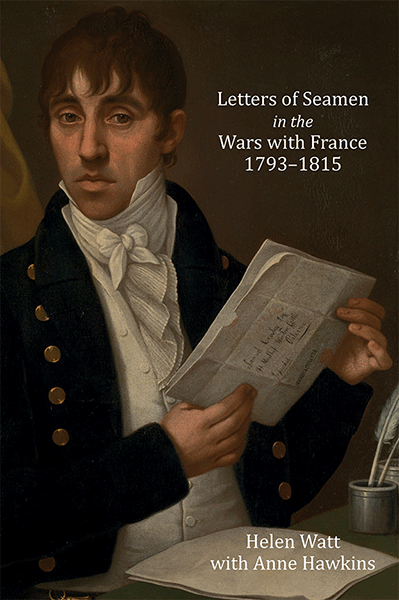
Front cover of ‘Letters of Seamen in the Wars with France’
This month I thought we might impart a nautical flavour to our reading recommendations. What small boy (and girl) has not dreamed of life on the ocean waves?
Many do follow that dream. Indeed in earlier times many did not even wait to grow up first. Horatio Nelson began his naval career at 13, serving as Ordinary Seaman on the HMS Raisonnable; Jane Austen’s brother enrolled in the Royal Naval Academy aged 11. Once at sea the reality sometimes did not live up to expectation and their letters home can betray disappointment as well as discovery.
I have said before how reading letters is a portal to another time (a Tardis in calligraphy perhaps). A particularly interesting collection of nautical letters is brought together in Helen Watt’s and Anne Hawkins’ Letters of Seamen in the Wars with France 1793-1815.
This collection is unusual in that it focuses on the lower ranks, the life below decks. When I was a child and used to tell my grandmother how wonderful it would have been to live 100 years ago in a big house and wear beautiful dresses; she always tartly responded (a great woman, my grandmother, but not one to suffer we fools gladly) that I would not have got to wear the pretty dress but would have been up at 06:00 black-leading the grate. This is the case for so many and insights into the lives of the less exalted are far more valuable for the majority of us in understanding how our ancestors may have lived than stories of the aristocracy.
By the 18th century literacy had spread and it was not only the well-born who could write home. It is to this resource that Watt and Hawkins have turned. The level of detail expressed by letters here is absorbing and the juxtaposition of great events and petty concerns puts a very personal face on events of the time. For example, Foulk Humphrey wrote to his daughter in 1797 giving a stirring eyewitness account of Nelson’s boarding of Spanish ships in the Battle of Cape St Vincent. James Atkins alludes to an unspecified quarrel with his aunt ‘the principle cause of my mysery’.
The period covered is a fascinating time and as well as significant battles it includes letters from Royal Naval mutiny of 1797 (perhaps more in the nature of a strike for pay and conditions). The vivid insight provided into the emotions of those involved is invaluable. As ever concerns over health, distress at being parted from family and ongoing issues about pay beset the correspondents. It is also interesting to see how some are frustrated or annoyed at the situation which was, as so many things for people of this class were, outside of their control or interest but materially affected their well being.
For serious researchers this book is well structured with a chapter of useful biographies of the correspondents, a select list of ships involved in the mutinies and a detailed bibliography. But for me its real charm lies in the voices it uncovers and the stories they tell of other lives in other times. If you find this interesting and would like to learn more about the lives of the people involved then I would also recommend Jack Tar by Roy and Lesley Adkins, which contains a wealth of detail about the lives of ordinary seamen at the time.
If you would like to look at things from a different perspective and, indeed, in a different age then have a look at the latest co-branded title from Amberley and The National Archives: Admiralty Dispatches. Far from the view from below decks this is the view from the bridge. Professor G H Bennett has collected the dispatches prepared by commanding admirals during the Second World War. This is another, albeit perhaps more familiar, fascinating period and his book includes the official dispatches prepared after the Dieppe Raids, D-Day and The Battle of Crete evacuation. The accompanying text puts the events in perspective, but what is most interesting is the dispatch itself which, knowingly written for publication (the dispatches had been published since the French wars of 1792-1815) seeks to explain as well as document events.
For those who enjoy these and seek more seafaring tales, then one to look forward to is Tales From the Captain’s Log, coming in late summer from Bloomsbury. This has used material from The National Archives to compile a visually stunning and absolutely riveting collection of pictures and stories from logs, diaries and letters over several centuries. There are insights into well-known events, including Captain Cook’s voyages to the Pacific or battle reports from Trafalgar, but as interesting are stories from ship’s doctors relating the hideous diseases (and even worse cures) experienced on board ship or the wondrous amazement of naturalists discovering birds, plants and animals they had never so much as imagined. Make a note now: this is definitely one to watch for.